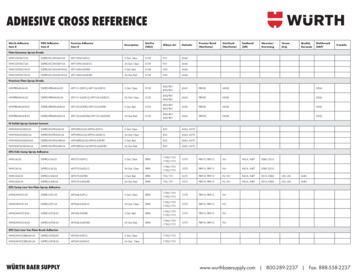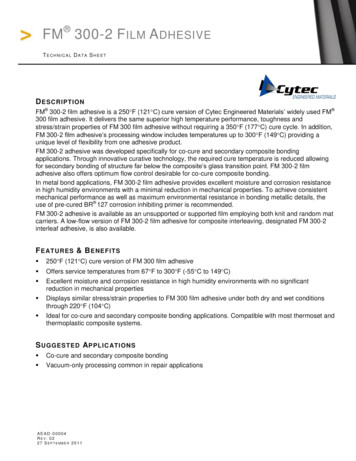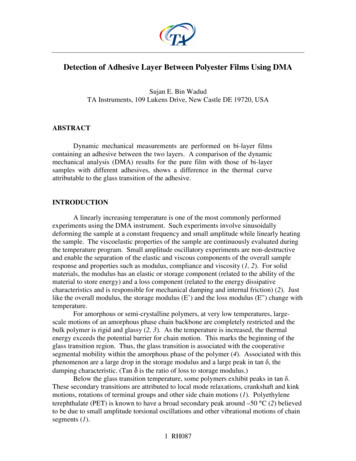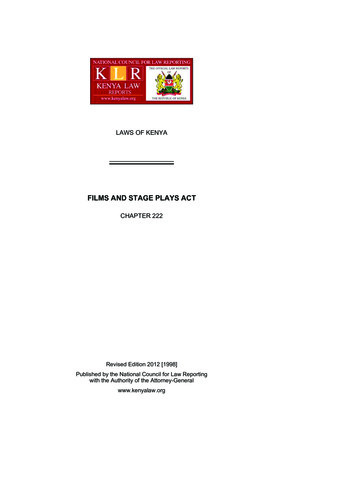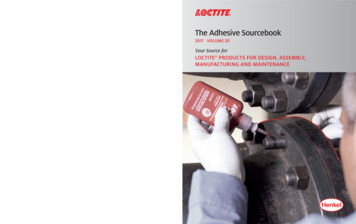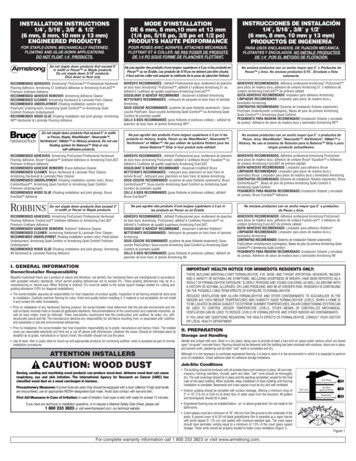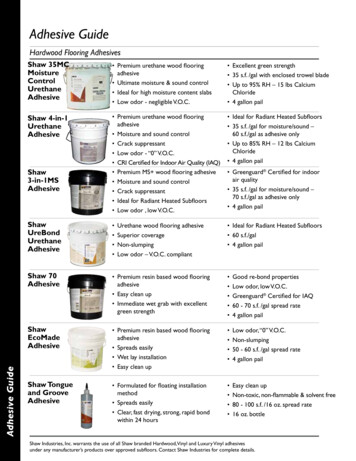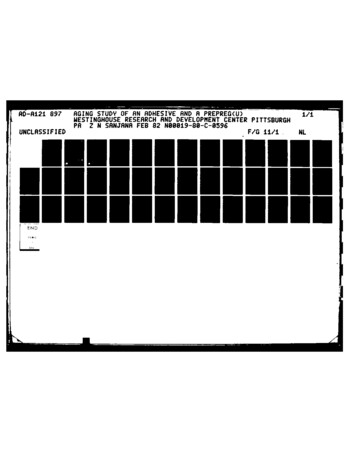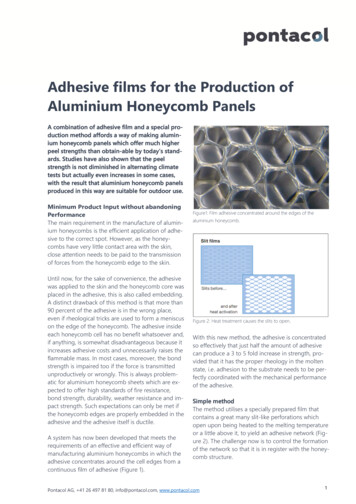
Transcription
Adhesive films for the Production ofAluminium Honeycomb PanelsA combination of adhesive film and a special production method affords a way of making aluminium honeycomb panels which offer much higherpeel strengths than obtain-able by today’s standards. Studies have also shown that the peelstrength is not diminished in alternating climatetests but actually even increases in some cases,with the result that aluminium honeycomb panelsproduced in this way are suitable for outdoor use.Minimum Product Input without abandoningPerformanceThe main requirement in the manufacture of aluminium honeycombs is the efficient application of adhesive to the correct spot. However, as the honeycombs have very little contact area with the skin,close attention needs to be paid to the transmissionof forces from the honeycomb edge to the skin.Until now, for the sake of convenience, the adhesivewas applied to the skin and the honeycomb core wasplaced in the adhesive, this is also called embedding.A distinct drawback of this method is that more than90 percent of the adhesive is in the wrong place,even if rheological tricks are used to form a meniscuson the edge of the honeycomb. The adhesive insideeach honeycomb cell has no benefit whatsoever and,if anything, is somewhat disadvantageous because itincreases adhesive costs and unnecessarily raises theflammable mass. In most cases, moreover, the bondstrength is impaired too if the force is transmittedunproductively or wrongly. This is always problematic for aluminium honeycomb sheets which are expected to offer high standards of fire resistance,bond strength, durability, weather resistance and impact strength. Such expectations can only be met ifthe honeycomb edges are properly embedded in theadhesive and the adhesive itself is ductile.A system has now been developed that meets therequirements of an effective and efficient way ofmanufacturing aluminium honeycombs in which theadhesive concentrates around the cell edges from acontinuous film of adhesive (Figure 1).Figure1: Film adhesive concentrated around the edges of thealuminium honeycomb.Figure 2: Heat treatment causes the slits to open.With this new method, the adhesive is concentratedso effectively that just half the amount of adhesivecan produce a 3 to 5 fold increase in strength, provided that it has the proper rheology in the moltenstate, i.e. adhesion to the substrate needs to be perfectly coordinated with the mechanical performanceof the adhesive.Simple methodThe method utilises a specially prepared film thatcontains a great many slit-like perforations whichopen upon being heated to the melting temperatureor a little above it, to yield an adhesive network (Figure 2). The challenge now is to control the formationof the network so that it is in register with the honeycomb structure.Pontacol AG, 41 26 497 81 80, info@pontacol.com, www.pontacol.com1
Adhesive Films for Aluminium Honeycomb PanelsFor this, three basic conditions must be met:1. The film must rest freely on the honeycomb core2. The film must be stretched biaxially, i.e., the polymer molecules must be homogeneously orientedin the surface3. The film must contain a pattern of slitsThe «secret» of this bonding method lies in the factthat the adhesive automatically seeks out the edges atthe very moment that heat is being transferred to theadhesive film. However, the process needs to beadapted so that these conditions are met. Althoughtime-consuming process optimisation is needed before industrial use, the results make it worth-while.Comparison of the bond strengths yielded by thismethod with those of other adhesive methods showsit is extremely effective at producing aluminium andsteel honeycomb panels. Compared with conventionalaluminium honeycomb panels, not only are much better peel strengths achieved but the flexural strengthstoo are similar, and even the creep resistance at elevated temperatures is usually sufficient.The resulting strength is astonishing, even on untreated metal, and nor are small amounts of drawingoil able to detract from this performance, as they exhibit outstanding compatibility with the apolar adhesive films.WeatherabilityCladding panels are exposed particularly intensively tothe elements for protracted periods. To examinewhether the panels produced by the new method areequal to the ever-increasing climatic stress, alternatingclimate tests in a humid climate followed by very lowtemperatures were performed in very quick succession. This accelerated aging was carried out for threemonths. Moreover, the honeycomb panels were continuously exposed to a salt spray environment for onemonth. Although this attacked the untreated aluminium surface, it failed to cause infiltration of the adhesive layer and so did not lead to delamination. Nor didthese harsh conditions impair the excellent strength ofthe bond between the skin and the honeycomb core.Attainable strengthsThe strength tests were performed on six different filmadhesives at a specific weight of about 100 g/m2.These are all olefinic films modified with MAH (maleicanhydride). The melting ranges vary with theFigure 3: Change in strength for different process temperatures.Figure 4: Schematic illustration of the method, which can alsobe performed discontinuously with heated platen presses ifnecessary.degree of co-polymerisation and the chemical natureof the basic chain, but lie between 80 C and 160 C.All six adhesive films show excellent adhesion to untreated metal but differ in their rheology in the moltenstate and in their potential for plastic deformation inthe solid state – these are parameters which substantially affect the bond strength. The properties of thefilms and bonded honeycomb panels are presented inTable 1. The optimum process temperature for a givenprocess time can be determined with the aid of Figure3, from which the maximum of the strength curve andthus an optimum process temperature window can bediscerned.Comparison of the strength values of non-pre-coatedhoney-comb cores and pre-coated honeycomb cores(Figure 3) and the plastic deformation undergone bythe layer of adhesive when the skin is peeled fromnon-pre-coated honeycomb cores and from precoated honeycomb cores (Figure 5 and 6) reveals thatembedding the honeycomb edge in the pre-coatedadhesive (process details in Figure 4) yields much better results.Pontacol AG, 41 26 497 81 80, info@pontacol.com, www.pontacol.com2
Adhesive Films for Aluminium Honeycomb PanelsHowever, once the optimum process time for a givenprocess temperature has been determined, attainmentof the maximum bond strengths with time is found tobe asymptotic, i.e. the temperature critically determines how quickly the required process time isreached. Figure 7 shows how to determine the process time when, for example, the process temperaturemay not exceed 125 C, this with or without pre-treatment.Comparison of mechanical valuesAluminium honeycomb panels are widely producedusing 2 component adhesives (2C PUR or 2C EP), usually at a rate of about 300 g/m2. Figure 8 juxtaposesthe properties obtained when different adhesive systems are used; for comparison, a 2C polyurethane anda 2C epoxy resin are shown as well. The chosen reactive adhesives, Pontacol RP 3007 and RE-EC, arestandard 2C systems which lead to relatively low peelstrengths even though significantly more adhesive wasused than in the film adhesive method. Significant improvements in this regard are offered by new, thermally activated 2C polyurethane systems, but thesestill have deficits compared to the film adhesives presented here.Figure 5: Peeled-off skin with pre-coating.Creep strengthHoneycomb panels are exposed to extremely high local stresses (honeycomb edges), which constitute adanger to the heat resistance. As shown in Figure 9,which illustrates the results of drum peel tests performed at various temperatures ranging from roomtemperature to 115 C, thermoplastic film adhesivescertainly have the potential to bond honeycomb panels to the extent that the heat resistance required foroutdoor applications is achieved. Three different filmadhesives were used in this study, in which the samebonding technology was always employed. Surprisingly, there is no direct correlation between meltingrange and heat resistance. 22.001-125 g softens between 115 C and 130 C, 22.111-100 g between 120 Cand 130 C, 23.111-100 g between 140 C and 150 C.Nevertheless, we find that 22.001, on account of itsstrong tendency to flow at elevated temperatures, exhibits sufficient heat resistance only up to 60 C,whereas 22.111, which has a slightly higher meltingrange, can be used up to about 95 C. It is also surprising that 23.111, with a much higher melting range,cannot be used at much higher temperatures than22.111, as the peel strength measured at 100 C was ona par with that for 22.111. This shows that the softeningrange alone is no guarantee of adequate heat resistance. Also, 3- and 4-point bending tests conductedfor comparison with bonds made with a reactiveepoxy adhesive system show that thermo-plastic filmadhesives are certainly able to compete in terms ofstrength at half the quantity of adhesive up to 80 C.The mechanical properties measured on commerciallyavailable panels are summarized in Table 1.Impact strengthAluminium honeycomb panels were subjected to impact in three different directions. Steel hammersweighing 7–10 kg were propelled at a speed of about50 km/h, both across and at the 3 honeycomb panels bonded with various adhesives, and the forcecurve necessary for the hammer to penetrate thehoneycomb panel was recorded. Figure 10 shows theresistance which a honeycomb panel offers to destruction by impact in the cleavage mode at constantimpact force/energy, but different bonding modes.Figure 6: Peeled-off skin without pre-coating.Pontacol AG, 41 26 497 81 80, info@pontacol.com, www.pontacol.com3
Adhesive Films for Aluminium Honeycomb PanelsFigure 7: Dependence of drum peel strength upon curing time asper DIN 53 295.Figure 10: Change in force during impact strength test and associated test specimens after the test.Figure 8: Drum peel strength determined as per DIN 53 295 in[N.mm/mm] following climate sequence tests (according to conditions in Table 2)Figure 9: Drum peel test as per DIN 53 295 at different temperatures.The green curves show the resistance of a honeycomb panel which was bonded with 300 g/m2 2CPUR. The blue curves represent the resistance of apanel which was bonded in a conventional mannerwith a thermoplastic film adhesive (22.111-100 g). Thered curves show the strength values obtained for thesame film adhesive, but applied as mentioned aboveby the innovative technique of concentrating the adhesive at the honeycomb edges. The fracture energyis significantly higher than in the case of the 2C PURbond, even though only 1/3rd of the weight of adhesive was used. This technology therefore offers significant technical advantages, without the need to allow for increased costs. A picture of the destroyedsample under the diagram illustrates the degree ofplastic deformation, which arose from the strong resistance offered during impact.ConclusionThe method presented here, which utilises a film adhesive with slit-like perforations, affords a way ofmaking aluminium honeycomb panels that is economical on adhesive and does not sacrifice performance. Under certain conditions, this new methodcan yield 3 to 5 times the strength of a conventionalepoxy resin, with half the amount of adhesive. Various practical trials performed under industrial conditions have shown that the new method requires just75 g/m2 film adhesive to achieve the required properties.Pontacol AG, 41 26 497 81 80, info@pontacol.com, www.pontacol.com4
Adhesive Films for Aluminium Honeycomb PanelsProperties/DesignatonsUnitRE-ECPontacol 22.111Thickness (ASTM C366)mm10 0,310 0,3Panel Weight (ASTM D898, DIN 53 855)kg/m24,604,30Compression Resistance (ASTM C365, DIN 53 291)MPa4,254,25Drum Peel Resistance (ASTM D1781, DIN 53 295)LongitudinalTransverseNmm/mm 50 50 250 2504 Point-Bending Test (ASTM C393, DIN 53 293)LongitudinalTransverseFlexion at 450 N, Center longitudinalFlexion at 450 N, Center transverseN170015404,905,44148014206,006,103 Point-Bending Test (ASTM C393, DIN 53 e Exposure to Temperature Range C-55 C bis 100 C-55 C bis 80 CmmmmTable 1: Test scores for aluminium honeycomb panels made with 300 g/m2 EP-adhesive (RE-EC) or. 150 g/m2 film adhesive (Pontacol 22.111)Pontacol AG, 41 26 497 81 80, info@pontacol.com, www.pontacol.com5
Adhesive Films for Aluminium Honeycomb PanelsPropertiesUnitChemical LDPEHDPEPPMelting range (Kofler bench)[ 150Melt Flow Index DIN 53735 (190 C/21.2 N)[g/10 40,930,900,910,930,91Minimal bond line temperature[ C]100115130140140165Open timesec 1 1 2 1 1 1Heat deflection temperature (DMTA)[ C]7580–90105110120135Plasticizer resistancen.a.nonononononoPressing timemin533555Pressing pressurebar 1 1 1 1 1 1Pressing temperature[ C]1051201551551551702Adhesive film weight[g/m ]10095100100100100Shear modulus[MPa]206060100800360Modulus of elasticity[MPa]20120115751460870Yield stress[MPa]44,83,87,713,917,2Tensile strength[MPa]2624,314,12713,930,3Ultimate strain[%]11001020143012004601050Lap shear strength on aluminium (LSS)23 C[MPa]1010,2111212,811LSS47 C[MPa]566,51010,69,6LSS70 C[MPa]0,71268,28LSS90 C[MPa]------0,5467,5Climbing drum peel strength (DPS)23 C[Nmm/mm]51 254 4254 13265 2639 3250 19DPSafter 14 days SST35 C[Nmm/mm]76 549 5239 3298 30------DPSafter 28 days SST35 C[Nmm/mm]73 348 2245 22314 19------DPSafter 30 days CST23 C[Nmm/mm]153 17103 9245 11261 2422 2230 25DPSafter 60 days CST23 C[Nmm/mm]186 16118 9176 35301 4---209 30DPSafter 90 days CST23 C[Nmm/mm]196 15127 12239 13306 11---214 28SST Salt spry test at 35 CCST (Climate sequence test)40‘ 23 C, 30% r.F., 90‘ cooling / 60‘ 35 C, 30% r.F., 80‘ heating / 120‘ 50 C, 80% r.F., 30‘ heating / 240‘ 80 C, 30% r.F.Pontacol bonding process is a binding condition to obtain the above mentioned properties. Pontacol AG, Switzerland, 03.2021Table 2: Aggregate data for bonded honeycomb panels.Pontacol AG, 41 26 497 81 80, info@pontacol.com, www.pontacol.com6
the properties obtained when different adhesive sys-tems are used; for comparison, a 2C polyurethane and a 2C epoxy resin are shown as well. The chosen reac-tive adhesives, Pontacol RP 3007 and RE-EC, are standard 2C systems which lead to relatively low peel strengths even though significantly more adhesive was used than in the film adhesive .



